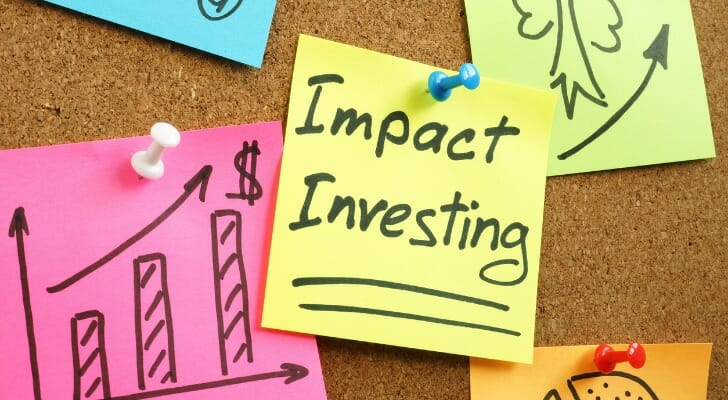Impact investing is a strategy for using your money to create or affect positive change by investing in things that will do good in the future. ESG, on the other hand, is a framework for evaluating and selecting investments based on the good they have historically done in the world. While they are similar on the surface, there are key distinctions between these two approaches. We’ll break down impact investing vs. ESG in more detail below. If you’re interested in either, a financial advisor can help you integrate impact investing or ESG into your portfolio.
What Is ESG Investing?

Environmental, social and governance (ESG) investing is a portfolio management approach that emphasizes the nature of its underlying investments. When employing ESG principles, the financial manager builds a portfolio or fund out of assets that comply with a specific mission. For example, they avoid all fossil fuels and invest only in companies with a net-zero carbon footprint. Another portfolio or fund may only invest in companies with significant female leadership. A financial manager using ESG will look at the nature of an investment based on how it has historically behaved, and will invest accordingly.
The key to understanding ESG is that it is a way of constructing investment portfolios in the ordinary course of business. That is to say, absent specific circumstances, an ESG portfolio must comply with all other fiduciary, disclosure and other financial requirements. A portfolio manager will find a group of assets based on traditional requirements of risk, return, price and other market metrics. They will then select specific investments from this pool of options based on ESG priorities.
ESG is occasionally thought to be simply a marketing technique for portfolio managers. While this is not entirely correct, it’s also not entirely inaccurate. An ESG portfolio is a standard fund or portfolio built out of assets selected for their relationship to specific environmental, social or governmental goals, built for investors who want to prioritize those goals.
What Is Impact Investing?
Impact investing is an investment approach that attempts to create mission-based change while also generating a positive financial return. Impact investment can apply to any kind of investment, from startup funding to portfolio construction. The purpose of this approach is to fund, reward or incentivize investments that create a specific form of change.
For example, an impact investor may seek out alternative energy startups to invest in, or they may invest in companies that create new career opportunities for women. This is a forward-looking approach. An impact investor will try to create change by giving someone the money they need to succeed.
Impact investing can apply in both the private and the public context. Retail investors can pursue impact investing by choosing publicly available assets based on their potential to create change, rather than the historic nature of their business and practices. However impact investing is more common among accredited investors, as this is a common practice for startup funding.
This is still investing, however. Impact investors expect a return on their money alongside measurable mission-based change.
How Do ESG and Impact Investing Differ?

An ESG investment is generally a collection of assets bundled into a portfolio. The portfolio manager will select those assets based on certain past performance benchmarks. An impact investment can be any kind of investment, but it’s often a single company or asset selected for what it hopes to achieve in the future.
On a more detailed basis, perhaps the best roundup of the differences between ESG and impact investing comes from an article published in the Stanford Social Innovation Review. The author, Jaclyn Foroughi, identifies six key metrics that distinguish these approaches:
Overall Approach vs. Individual Strategy
An ESG investment is a framework for building portfolios. It’s how you analyze risk and reward for a standard investment, or a group of investments, in the context of a specific mission. Impact investing is a specific strategy for achieving a goal through investing.
Fiduciary Scrutiny
An asset manager must apply ESG principles in the context of their existing fiduciary duties. They cannot invest in assets that they otherwise wouldn’t, nor can they substitute their own sense of ethics for the client’s best financial interest.
Impact investing often does not have to meet these standards, either because the investment requires accreditation or because a given asset will specifically declare its intention to prioritize impact alongside returns.
Risk Profiles
An ESG approach tends to either mitigate risk or seek opportunities. An investor can use ESG goals to screen for past behavior that indicates potential problems in the future, or they can use ESG goals to identify investments that have already solved some market problems. However, the backward-looking nature of ESG means that investors can typically do only one or the other.
Impact investing tends to seek both risk mitigation and opportunity. By looking for companies that are trying to actively create change, a successful impact investment creates an opportunity by investing in companies that actively mitigate or solve risks.
Primacy of Returns
Again due to the backward-looking nature of the approach, ESG portfolios tend to put returns first by default. They look for successful investments, then screen those assets based on the mission goals of the portfolio.
The forward-looking approach of impact investing puts returns and mission on an equal footing. Impact investors can simultaneously analyze an investment’s potential to create change and its potential for returns, eliminating any investments that don’t meet both criteria.
Public vs. Private
Historically, ESG has been a way of assessing all assets in the marketplace. This means that it’s generally used much more often to analyze public investments, and used as a basis for constructing publicly available portfolios.
By contrast, impact investors have tended to be private, accredited investors. In particular, investors tend to invest in private and startup companies trying to achieve a mission.
The public vs. private distinction is not inherent to the nature of ESG and impact investing, but it is a historic pattern.
Cross-Definition Relationship
All impact investing is ESG-compliant, because an impact investor uses environmental, social or governmental goals to assess impact investments. They will not invest in an asset that doesn’t at least intend to meet ESG goals.
Not all ESG investments are impact investments, though. An ESG investor isn’t necessarily trying to create change, they may simply want to invest around certain ideals. At the same time, these investments are chosen based on their historic behavior, not necessarily based on their future potential.
Bottom Line
Impact investing is the process of investing in assets that you think will make a difference in the future. Environmental, social and governance (ESG) investing is the process of investing in assets that currently meet your personal goals.
Investing Tips
- If you’re interested in ESG and impact investing, talk to a financial advisor about how to add more conscious investments to your portfolio. Finding a financial advisor doesn’t have to be hard. SmartAsset’s free tool matches you with up to three vetted financial advisors who serve your area, and you can interview your advisor matches at no cost to decide which one is right for you. If you’re ready to find an advisor who can help you achieve your financial goals, get started now.
- With inflation remaining elevated, it’s important to consider its impact on your portfolio. SmartAsset’s inflation calculator provides you an estimate of how much your assets could be worth in the future based on the rate of inflation.
Photo credit: ©iStock.com/designer491, ©iStock.com/enot-poloskun, ©iStock.com/FreshSplash
